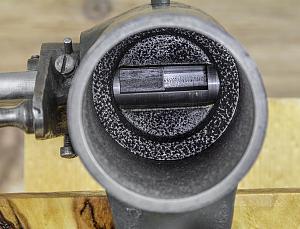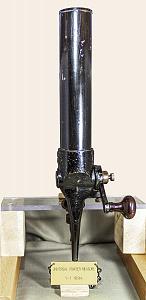
|
   
   
|


|

I would guess that it’s shop-made. Finish level is “good enough” to work, or, as somebody famously said, “Don’t be a hero. Milling is a finishing operation.”
I can’t tell by the pictures if the powder chamber/hopper and clamping bosses are well-done welded attachments or maybe the machinist/maker knew a patternmaker (or was one himself) and had access to a foundry.
I’m currently driving myself crazy just trying to make a custom snap-in shellholder for a standard reloading press. The skills other people have constantly amaze me.
By the way, Ken, great job on the latest ARTCA Journal!

Dave, more pictures. I am not sure, the casting is pretty good, there are some bubble holes but overall it is well made. The finish grinding is rough. The machining on the casting and all the operating parts is 1st class. As the picture shows the measure is leaning to the right, it also leans to the rear because the thumb screw and lip and not square to the body.
The fit of the drum and slides is near hand-lapped quality. The design copies the Ideal #5, though without some of the refinement. For instance there is no vinier markings on the slides. There are two slides that can be set independently of each other, or together. The main drum is made in two pieces with the inside cap held in place with two screws, this allows simpler machining of the slide way, though the assembly is a bit complicated. THe end cap has no readily discernable joint line so it took a while to figure out what the two set screws in the end were for. There are also two 1/8" holes in the cap to put pins in for threading the cap on and snugging it down. There is a brass sleeve inside the body for the slide to operate in. it is secured by a single screw in the front of the hopper body.
Small set screws lock the slides together and the bottom one in the closed position if just one slide is needed. Slide design resembles the Ideal #5 Micrometer, but more versatile. The paint color and appearance suggest early to mid 1930's production. The top lip of the hopper has a nice machined profile that would indicate there was a cast iron lid that has long since disappeared. The inside of the hopper is well machined and finished.
I may do a compare and contrast with the Comer measure for the March issue as the style of the two is very similar, though they operate very differently. Maybe ad in the #5 Micrometer also.

ken will bet is older than you say and could very well be a Lyman pro type, all things appear to be a pre no 3 /5 ,Lyman was first to try the [hammer-type paint } really the paint was because it was too cold and made the hammer look, but it stuck . and many used it for years ,
rick

No, not an Ideal prototype, but a competitor. The drum design clearly follows the Ideal #5M, micrometer measure of the mid 1930's. All the Ideal measures including those made by Lyman have a black japan finish. The first Ideal is the UPM from 1894. It was followed by two versions of the #1, #2, #3, #4, then in 1903 the #5 & #6 that have the current drum design as the #55. Lyman took control of Ideal in 1926 and made no changes to the line until the 5M.
There is a written history of the Ideal measures in the works for this spring.
The UPM

It resembles the Potter Measure in function, but is round.
I'm going to be watching this one, just for my own edification.
_________________________________________________It's not that I can't spell: it is that I can't type.
| BP | Bronze Point | IMR | Improved Military Rifle | PTD | Pointed |
| BR | Bench Rest | M | Magnum | RN | Round Nose |
| BT | Boat Tail | PL | Power-Lokt | SP | Soft Point |
| C | Compressed Charge | PR | Primer | SPCL | Soft Point "Core-Lokt" |
| HP | Hollow Point | PSPCL | Pointed Soft Point "Core Lokt" | C.O.L. | Cartridge Overall Length |
| PSP | Pointed Soft Point | Spz | Spitzer Point | SBT | Spitzer Boat Tail |
| LRN | Lead Round Nose | LWC | Lead Wad Cutter | LSWC | Lead Semi Wad Cutter |
| GC | Gas Check |